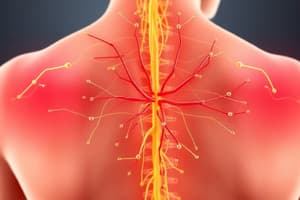Podcast
Questions and Answers
Which of the following is NOT a typical effect of pain on a person's life?
Which of the following is NOT a typical effect of pain on a person's life?
- Impact on quality of life
- Reduced sense of well-being
- Strain on financial resources
- Improved family and friend interactions (correct)
Neuropathic pain follows the typical phases of nociceptive pain.
Neuropathic pain follows the typical phases of nociceptive pain.
False (B)
What are the two main processes that lead to the development of pathologic pain?
What are the two main processes that lead to the development of pathologic pain?
nociceptive and neuropathic processing
Pain is often called the _____ vital sign.
Pain is often called the _____ vital sign.
Which of the following best describes the role of nociceptors?
Which of the following best describes the role of nociceptors?
Match the following phases of nociceptive pain with their description:
Match the following phases of nociceptive pain with their description:
Which of the following is a characteristic of neuropathic pain?
Which of the following is a characteristic of neuropathic pain?
Nociceptive pain cannot turn into neuropathic pain over time.
Nociceptive pain cannot turn into neuropathic pain over time.
Which of the following is an example of neuropathic pain?
Which of the following is an example of neuropathic pain?
Visceral pain is often described as sharp and burning.
Visceral pain is often described as sharp and burning.
What does the acronym FLACC stand for in pain assessment?
What does the acronym FLACC stand for in pain assessment?
Pain that is felt at a particular site but originates from another location is called ______ pain.
Pain that is felt at a particular site but originates from another location is called ______ pain.
Match the following pain types with their descriptions:
Match the following pain types with their descriptions:
Which of the following is the most reliable indicator of pain?
Which of the following is the most reliable indicator of pain?
Chronic pain always stops when the injury heals.
Chronic pain always stops when the injury heals.
The _____ rating scale is the most common pain-rating scale.
The _____ rating scale is the most common pain-rating scale.
What does the 'U' stand for in the PQRSTU pain assessment tool?
What does the 'U' stand for in the PQRSTU pain assessment tool?
Which of the following describes deep somatic pain?
Which of the following describes deep somatic pain?
Aging adults are less likely to experience pain compared to younger adults.
Aging adults are less likely to experience pain compared to younger adults.
The Brief Pain Inventory asks the patient to rate pain within the past ____ hours.
The Brief Pain Inventory asks the patient to rate pain within the past ____ hours.
List two common behaviors associated with acute pain.
List two common behaviors associated with acute pain.
When assessing pain in an infant, it is most appropriate to use what kind of approach?
When assessing pain in an infant, it is most appropriate to use what kind of approach?
Match the following pain assessment tools with the appropriate patient populations:
Match the following pain assessment tools with the appropriate patient populations:
Flashcards
Pain
Pain
An unpleasant signal that something hurts, feels bad, or is an unpleasant physical feeling.
Nociceptive Pain
Nociceptive Pain
Pain that arises from stimulation of intact nerve fibers in the periphery and CNS.
Neuropathic Pain
Neuropathic Pain
Pain that arises from damage or dysfunction in the somatosensory nervous system.
Transduction (Pain Process)
Transduction (Pain Process)
Signup and view all the flashcards
Transmission (Pain Process)
Transmission (Pain Process)
Signup and view all the flashcards
Perception (Pain Process)
Perception (Pain Process)
Signup and view all the flashcards
Modulation (Pain Process)
Modulation (Pain Process)
Signup and view all the flashcards
Nociceptors
Nociceptors
Signup and view all the flashcards
Visceral pain
Visceral pain
Signup and view all the flashcards
Somatic pain
Somatic pain
Signup and view all the flashcards
Referred pain
Referred pain
Signup and view all the flashcards
Phantom limb pain
Phantom limb pain
Signup and view all the flashcards
Acute pain
Acute pain
Signup and view all the flashcards
Chronic pain
Chronic pain
Signup and view all the flashcards
Breakthrough pain
Breakthrough pain
Signup and view all the flashcards
OLD CARTS
OLD CARTS
Signup and view all the flashcards
PQRSTU
PQRSTU
Signup and view all the flashcards
Numeric rating scale
Numeric rating scale
Signup and view all the flashcards
Verbal descriptor scale
Verbal descriptor scale
Signup and view all the flashcards
Visual analogue scale
Visual analogue scale
Signup and view all the flashcards
FLACC scale
FLACC scale
Signup and view all the flashcards
Face scales
Face scales
Signup and view all the flashcards
Infant pain assessment
Infant pain assessment
Signup and view all the flashcards
Brief Pain Inventory
Brief Pain Inventory
Signup and view all the flashcards
McGill Pain Questionnaire
McGill Pain Questionnaire
Signup and view all the flashcards
Study Notes
Pain Assessment
-
Definition of Pain: Pain is an unpleasant sensory and emotional experience associated with actual or potential tissue damage, or described in terms of such damage. It's a signal that something is wrong.
-
Importance of Pain Assessment: Routine pain assessment is crucial in all health settings, considered the 5th vital sign, significantly impacting a patient's quality of life, interactions, and well-being. It's a frequent reason for seeking healthcare.
-
Types of Pain Processing:
- Nociceptive Pain: Pain stemming from stimulation of nociceptors, specialized nerve endings, signaling actual or threatened tissue damage. It involves four phases: transduction (initial stimulus), transmission (impulse to spinal cord), perception (awareness), and modulation (pain reduction).
- Neuropathic Pain: Pain arising from damage or disease affecting the somatosensory nervous system. It's characterized by abnormal processing of pain signals and often more challenging to treat and assess, sometimes developing from poorly controlled nociceptive pain.
-
Sources and Types of Pain:
- Visceral Pain: Originates from internal organs, often perceived as dull, deep, squeezing, or cramping. Caused by organ injury, ischemia, or distention. Frequently associated with autonomic responses (vomiting, nausea, pallor, sweating).
- Somatic Pain: Arises from musculoskeletal tissues or body surface. Deep somatic pain (e.g., joints, muscles) is often aching or throbbing, while cutaneous pain (e.g., skin) is sharp or burning. Caused by pressure, trauma, or ischemia. Usually localized.
- Referred Pain: Pain felt in one location but originating from another area. E.g., Appendix pain may be felt in the periumbilical area.
- Phantom Pain: Pain felt in an amputated limb
-
Classification by Duration:
- Acute Pain: Short-term, self-limiting pain, often following a predictable trajectory, resolving after injury heals.
- Chronic Pain: Diagnosed when pain lasts 6 months or longer, can be malignant (cancer related) or non-malignant, and persists beyond the healing process.
- Breakthrough Pain: Transient increase in pain level in a patient with otherwise controlled pain. Can be caused by end-of-dose medication failure.
Pain Assessment Tools & Methods
- Self-report (Subjective): Essential for pain assessment. Everyone experiences pain differently. Different scales are used according to a patient's ability, purpose, and time constraints.
- Pain Rating Scales:
- Numeric Rating Scales (NRS): Common scale (0-10).
- Verbal Descriptor Scale: Uses words to describe pain intensity (e.g., no pain to unbearable pain).
- Visual Analog Scale (VAS): Patient marks a line indicating pain intensity (0-10 cm).
- Nonverbal Assessment Tools:
- FLACC Scale: For infants and young children (Face, Legs, Activity, Cry, Consolability).
- Face Scales: Useful for older children (4-5 years old).
- Pain Assessment in Advanced Dementia (PAINAD): Used with dementia patients focusing on breathing, vocalization, facial expressions, body language, and consolability.
- More Comprehensive Assessments:
- Brief Pain Inventory: Chronic pain patients. Rates pain in relation to daily life impact (mood, walking, sleep etc.)
- McGill Pain Questionnaire: Chronic pain patients. Asks patients to rank descriptors in terms of intensity and provide overall pain ratings.
Pain Behaviors
- Nonverbal Behaviors: Important for assessing pain in individuals who can't verbally communicate it. Behaviors vary based on acute or chronic nature of the pain, age, culture, and gender expectations.
- Acute Pain Behaviors: May include guarding, grimacing, vocalizations, agitation, restlessness, stillness, sweating, or changes in vital signs.
- Chronic Pain Behaviors: Greater variability than acute pain behaviors. May include bracing, rubbing, diminished activity, sighing, and changes in appetite.
Developmental Considerations in Pain Assessment
- Infants: Employ a multi-faceted approach, considering their limited communication skills.
- Aging Adults: Pain is not considered normal in aging adults; be vigilant and proactive in assessing pain. They may deny pain to avoid losing independence. Observe activities, toileting, and any changes in routine.
- Individuals with Dementia: Pain is still present and they may communicate by nonverbal cues, using a scale like the PAINAD.
Studying That Suits You
Use AI to generate personalized quizzes and flashcards to suit your learning preferences.




